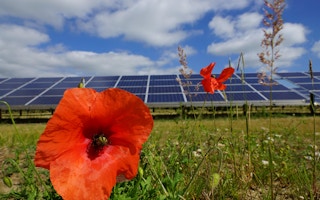Investment in renewable energy around the world is entering a new phase that will require governments and the private sector to re-think the way they develop projects.
For the last decade, renewable energy such as solar power and onshore wind has been playing a key role in providing energy access as well as reducing greenhouse gas emissions. However, over the past two years, global investment in renewable energy has been on the decline. Global investment in renewable energy peaked in 2017 at $326.3 billion, and in 2018 fell by 11.5 per cent to $288.9 billion, according to Bloomberg New Energy Finance. Global investment in renewable energy dropped 14 per cent in the first half of 2019 compared to the same period in 2018.
It is clear that global renewable energy investment is slowing down. What are the factors that have contributed to this declining trend, and should we worry?
The slower growth in renewable energy investment can be attributed mainly to falling costs in solar and wind globally, and to the change in market conditions with reduced subsidies in many countries.
On the one hand, the unit cost of solar photovoltaic (PV) systems and onshore wind power has been declining rapidly. The global weighted average of installed cost for solar PV was $4621/kW in 2010 and in 2018 was $1210/kW—a reduction of 73.8 per cent, according to the International Renewable Energy Agency. The installed cost for onshore wind power declined nearly 22 per cent from $1913/kW in 2010 to $1497/kW.
In other words, the needed investment is lower for installing the same level of solar or wind power capacity. Despite the 11.5 per cent decline in globally investment in renewable energy in 2018 from the previous year, the newly installed capacity remained the same in both years at 171 GW. As such, this is a welcome development, and certainly not a cause for anxiety.
On the other hand, renewable energy markets are becoming mature as more solar and wind projects can be financed on commercial terms in many countries through auction.
By 2030, solar PV will be the cheapest electricity source with its levelised cost at around $0.046/kWh, followed by onshore wind at $0.050/kWh, both will be much lower than coal power at $0.096/kWh, according to Energy Intelligence. In this context, governments around the world have started to phase out the subsidies to solar and wind in the form of feed-in-tariffs, that were put in place, when the cost of renewable energy was very high, to ensure an adequate return to investors.
In the People’s Republic of China for example, the government announced a substantial cut in the feed-in-tariff in June 2018, and also imposed an installation cap on the solar PV projects that are eligible to the feed-in-tariff. Under these circumstances, the People’s Republic of China installed 44GW of solar PV in 2018, 17 per cent lower than in 2018. There is a learning curve for investors to be able to compete with conventional power and cope with market risks, and market forces will eventually spur more solar and wind installations with more sustainable financing than relying solely on public sector subsidies.
So, the fall in renewable energy investment isn’t a cause for concern per se. But we should be very worried that 2018 was the first time since 2001 that growth in renewable power capacity addition failed to increase year-on-year. According to the International Energy Agency, new net capacity from renewable power sources increased by about 180 Gigawatts (GW) in 2018, the same as the previous year. That is only around 60 per cent of the net additions needed each year to limit global temperature rise well below 1.5 degrees.
Clearly, we need to do more. In addition to conducive and stable policies and regulations, four technology pathways should be explored in developing countries.
First, beyond solar PV and onshore wind, we need to develop other renewable power generation technologies such as offshore wind, concentrated solar power, flexible thin film solar, wave and tidal energy. The levelised costs of electricity of these renewable energy sources are still expensive, typically around $0.10-0.20/kWh, therefore policy incentives including feed-in-tariff should be maintained to scale up their deployment and bring down costs.
Second, beyond the renewable power generation, we need to invest more in transmission and distribution systems with smart grid technologies and energy storage systems. This will enhance the ability of grids to absorb more intermittent renewable power generation, and ensure that the electricity systems remain reliable and resilient.
“
The fall in renewable energy investment isn’t a cause for concern per se. But we should be very worried that 2018 was the first time since 2001 that growth in renewable power capacity addition failed to increase year-on-year.
Third, in addition to electricity power supply, we need to develop other forms of clean energy applications. These can include solar water heat collectors, geothermal district heating, hydrogen and fuel cells, electric vehicles and ships, biofuels, and biomass pellet fuels for efficient cooking stoves.
Fourth, we need to tackle the potential of demand-side energy efficiency in households, offices and commercial buildings and industries. Application of digital technologies including artificial intelligence and big data will enable consumers to save electricity through real time demand-response applications.
While it’s important to continue to invest in all forms of renewable energy generation, countries need to invest more money into smart electricity networks, clean heating and cooking, and demand-side energy efficiency.
New renewable technologies, once proven feasible, should be scaled up, as is already happening with the support of ADB other development partners. This will help bring the world back on track to achieve long term climate goals.
ADB will soon launch a call for proposals for $1.5 million innovation challenge in the following three areas: clean energy heating and efficient cooling; renewable energy based mini-grids with blockchain application in islands; and AI technology for demand-side energy efficiency in office and commercial buildings.
Yongping Zhai is Chief of Energy Sector Group, Sustainable Development and Climate Change Department at ADB; and Yoonah Lee is a young professional in the Sustainable Development and Climate Change Department at ADB. This blog has been republished with permission from the ADB blog.











